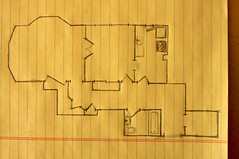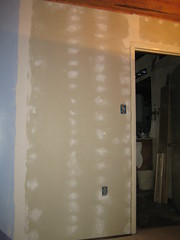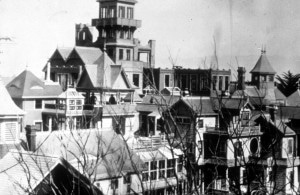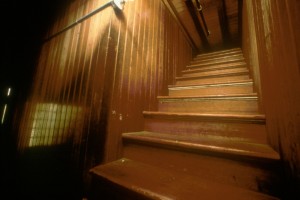I have a three-year-old, and as three-year-olds are wont to do, he likes to watch the same movie over and over and over for about two weeks straight. So when I wanted to show the three- and five-act structures in action, I knew I had to use his latest obsession: The Incredibles.
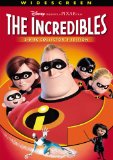 I’m comparing the different structures’ divisions of the “text” here, so the synopsis will be largely the same, but the placement of the acts will vary among the three act, Freytag’s five act and my five act structures.
I’m comparing the different structures’ divisions of the “text” here, so the synopsis will be largely the same, but the placement of the acts will vary among the three act, Freytag’s five act and my five act structures.
Three act structure
(Paragraphing is mostly for readability.)
Act I—Setup—the characters’ world (still with conflict): Super heroes were celebrated icons. Bob (Mr. Incredible) and Helen (ElastiGirl), super heroes, get married. Super heroes fall out of favor and are hidden by the government.
Fastforward 15 years, and Bob and Helen are trying to look like a typical suburban family. Bob is dissatisfied with his life. The kids aren’t happy with hiding (or having) their super powers. Bob loses his job.
First turning point: Mr. Incredible is offered a secret super hero assignment and decides to take it. He also decides not to tell his wife that he has been fired or offered this high-paying assignment.
Act II—Confrontation—lots of rising conflicts: Mr. Incredible completes the assignment on a remote island. When he returns for a second assignment, he finds out there’s a villain, learns of the villain’s secret plans and is captured. His wife and kids come to save them. They learn to use their powers together, but are captured. They watch as the villain’s dastardly plan plays out in their home town, then the villain leaves to play his role there as well.
Second turning point/climax: Working together, the family escapes and pursues the villain and his evil robot. They defeat the robot.
Act III—Resolution: They return home and save the baby from the villain. They’re now a family of super heroes, and are happy and united against the forces of evil.
Freytag’s Five Act Structure
Act I—Setup: Super heroes were celebrated icons. Bob (Mr. Incredible) and Helen (ElastiGirl), super heroes, get married. Super heroes fall out of favor and are hidden by the government.
Fastforward 15 years, and Bob and Helen are trying to look like a typical suburban family. Bob is dissatisfied with his life. The kids aren’t happy with hiding their super powers. Bob loses his job.
Act II—Rising Action: Mr. Incredible is offered a secret super hero assignment and decides to take it. He also decides not to tell his wife that he has been fired or offered this high-paying assignment. (This is really the divider between act I and II still.)
Mr. Incredible completes the assignment on a remote island. When he returns for a second assignment, he finds out there’s a villain and learns of the villain’s secret plans.
Act III—Turning Point/Midpoint: Suspecting her husband is doing something not-so-good, Helen activates the homing beacon in his super suit. She knows where he is now—but the homing beacon alerts the villain of Mr. Incredible’s presence and he’s captured again.
Act IV—Falling Action: (booooring name). Helen and the kids come to his rescue. They learn to work together as a team, but are ultimately captured. The villain attacks their hometown with his evil robot.
Act V—Resolution: They escape and defeat the evil robot. They return home and rescue the baby from the villain. They are happy and united as a family against the forces of evil.
My Five Act Structure
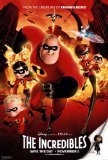 Act I—Setup: Super heroes were celebrated icons. Bob (Mr. Incredible) and Helen (ElastiGirl), super heroes, get married. Super heroes fall out of favor and are hidden by the government.
Act I—Setup: Super heroes were celebrated icons. Bob (Mr. Incredible) and Helen (ElastiGirl), super heroes, get married. Super heroes fall out of favor and are hidden by the government.
Fastforward 15 years, and Bob and Helen are trying to look like a typical suburban family. Bob is dissatisfied with his life. The kids aren’t happy with hiding their super powers. Bob loses his job.
Act II—Rising Action: Mr. Incredible is offered a secret super hero assignment and decides to take it. He also decides not to tell his wife that he has been fired or offered this high-paying assignment. (This is really the divider between act I and II still.)
Mr. Incredible completes the assignment on a remote island. When he returns for a second assignment, he finds out there’s a villain and learns of the villain’s secret plans.
Suspecting her husband is doing something not-so-good, Helen activates the homing beacon in his super suit. She knows where he is now—but the homing beacon alerts the villain of Mr. Incredible’s presence and he’s captured again.
Helen and the kids come to his rescue. They learn to work together as a team, but are ultimately captured.
Act III—Climax: The villain attacks their hometown with his evil robot. They escape and defeat the evil robot. They return home and rescue the baby from the villain.
Act IV—Falling action: A few months later, they attend a track meet for their son with superhuman speed (who was acting out in the setup b/c he had no other outlet), whom they finally let compete in sports. Their shy daughter is now confident enough to ask her long-time crush on a date—and he’s the one who gets flustered.
Act V—Resolution: As they leave a track meet, a new villain appears. They don their masks and grin, ready to take on the new challenge.
Quiz time: read Acts IV and V under My Five Act Structure. What’s the story question? Did they ask and answer the same question?


 In a romance, it’s “Will the boy win the girl?” In a mystery, it’s “Will they catch the murderer?” (And the answer is supposed to be yes on both of those!)
In a romance, it’s “Will the boy win the girl?” In a mystery, it’s “Will they catch the murderer?” (And the answer is supposed to be yes on both of those!)  A third way is to answer an intermediate question without satisfaction, making another answer (the story question) necessary. Maybe Horatio does with the Nobel Prize (because he passed off Jezebel’s work as his own, let’s say, and she is furious and leaves him and gets a lawyer). But even after he’s won, his life is empty. He misses her annotated love notes, her pocket protector, her obscure jokes. He tracks her down in her Antarctic research station, proclaims his love (and promises to publish the truth about her research).
A third way is to answer an intermediate question without satisfaction, making another answer (the story question) necessary. Maybe Horatio does with the Nobel Prize (because he passed off Jezebel’s work as his own, let’s say, and she is furious and leaves him and gets a lawyer). But even after he’s won, his life is empty. He misses her annotated love notes, her pocket protector, her obscure jokes. He tracks her down in her Antarctic research station, proclaims his love (and promises to publish the truth about her research).

